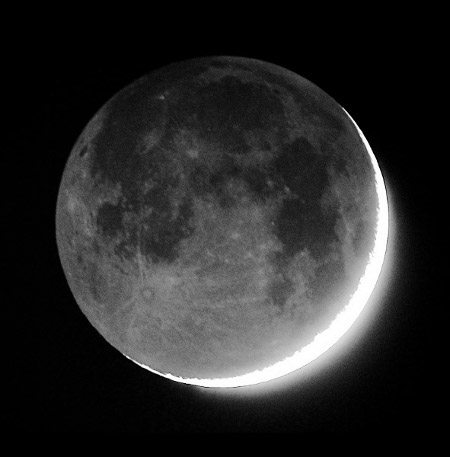Sky Report: April 12 – April 18

This is a quiet week, astronomically speaking, so let’s look at where the moon is each night.
On the 12th the moon is one day past new and you won’t see it, but can you see it the following evening?
On the 13th it will be the slimmest of crescents barely above the western horizon before the sky is fully dark, and you’ll need a very low horizon to spot it (and binoculars will help).
On the 14th you’ll be able to spot it, weather permitting, still the thinnest of crescents only 8% illuminated by the sun. On this night and the next few you’ll notice “the old moon in the young moon’s arms” – the dark part of the moon that is not illuminated by the sun will be illuminated by the earth, which is near its full phase as seen from the moon. Through a telescope you can make out the lunar seas and major craters on the dark side of the moon.
On the 15th the bright star Aldebaran in Taurus the Bull is only 5° to the lower left of the moon and you can see both together in most binoculars. The Pleiades Star Cluster, aka The Seven Sisters, is twice that distance from the moon to the lower right.
On the 16th the moon is 5° almost straight below the planet Mars, and on the following night it’s a similar distance above Mars. The moon and Mars are closest at 6 AM, but then both are far below the horizon – but if you’re on the opposite side of the earth, where it’s nighttime at that moment, they’ll be in conjunction and only 1° apart.
On the 18th the moon is in the middle of Gemini, the Twins.
The new 11-year sunspot cycle began last December. This winter there were few if any sunspots, but their number will increase slowly until the cycle reaches a peak around the summer of 2025, and that’s when there will be the most sunspots and solar activity. Solar filters are an optional accessory for most telescopes, so if you’d like to observe our star by day as well as the others at night, think about getting a solar filter. You can follow the sun’s activity at www.spaceweather.com and also get alerts for northern lights (auroras) which are triggered by solar activity and which will become more frequent in years ahead.
The Sky Report is presented as a public service by the Stellar Vista Observatory, a nonprofit organization based in Kanab, Utah, which provides opportunities for people to observe, appreciate, and comprehend our starry night sky. Additional information is at www.stellarvistaobservatory.org. Send questions and comments to
John@StargazingAdventures.org.






Comments are closed.